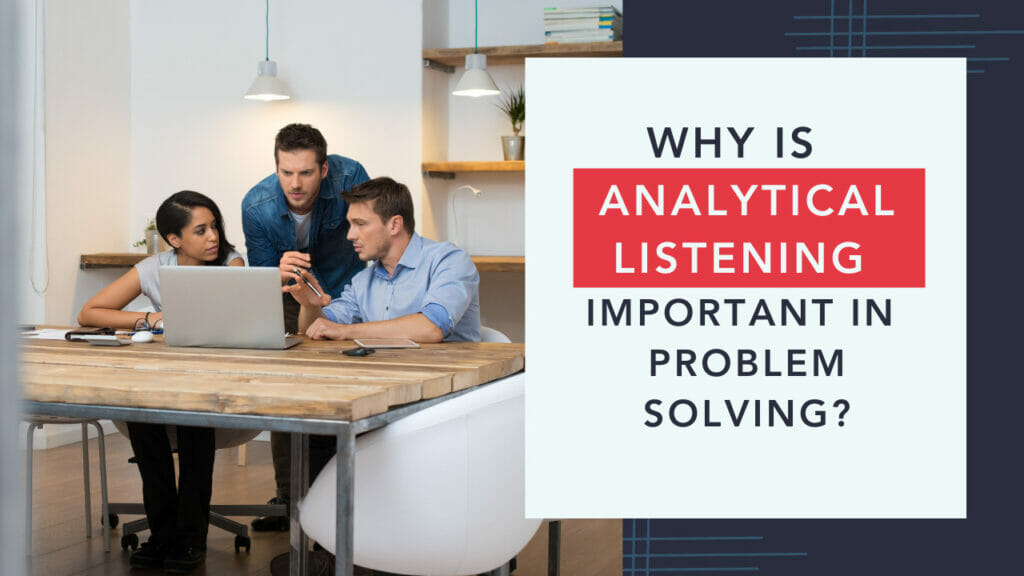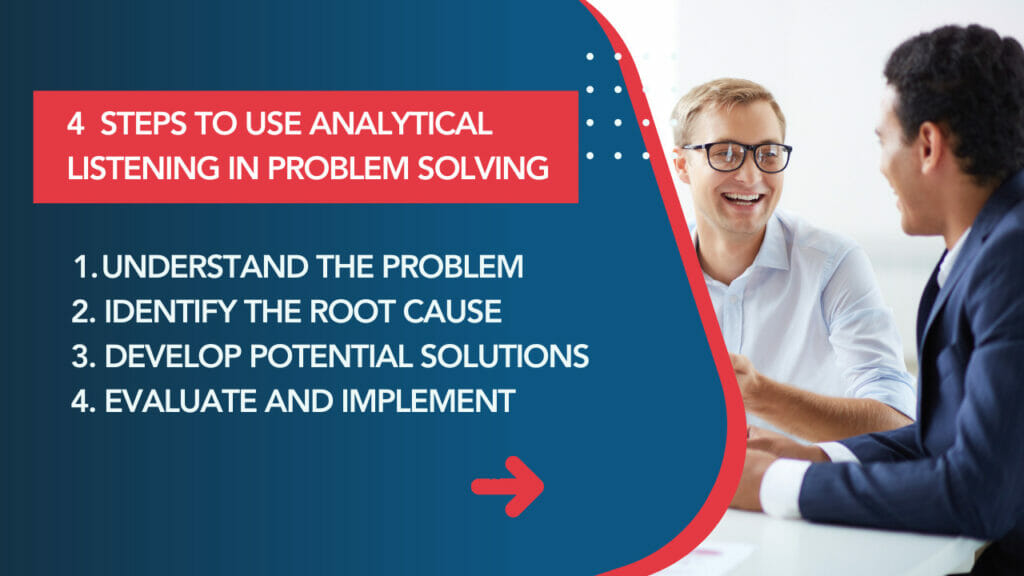4 Effective Steps to Use Analytical Listening in Problem Solving
Viktoriya maya, in this article, subscribe to our newsletter.
- First Name *
Analytical listening is a technique that can be used to identify different elements of a problem and find potential solutions. It involves breaking down a problem into smaller components and examining each part individually. In this article, we’ll take a look at what analytical listening is and what steps you can take to use analytical listening in problem-solving.
Learn and learn on the go!

Why is analytical listening important in problem-solving?
Analytical listening helps us understand the root cause of problems and find better solutions.
Listening with analytical thinking is important because it enables us to assess what we are hearing, whether information makes sense, how well data fits together, and if there might be a solution to the problem.

How can analytical listening help in our daily lives?
Because analytical listening allows you to assess what you are hearing before making judgments or taking action, this skill has many uses for day-to-day communication.
It can improve self-awareness when you ask yourself questions such as:
- “What am I interpreting from the speaker’s words and body language?”
- “Does this make sense? Does it fit in with what I know?”
- “What emotions am I experiencing right now, and are they affecting what I am hearing?”
- “What are some potential solutions to this problem?”
It can help you in your daily interactions by allowing you to clarify information that is important for making decisions. For example, analytical listening could be used when speaking with clients about their opinions on how well a product worked during testing.
You would ask analytical questions such as:
- “How did using our product compare to other products you have tried before?”.
- “What did you like about our product?”
- “What are some areas you think we could improve?”
- “Based on your experience, what do you think would be a good solution to this issue?”.
The client’s answers to these questions can help your team understand what worked well and what could use improvement.
This allows clients who may not be very descriptive about their experiences an opportunity to share more details so both parties can come up with solutions together. It also gives the option of asking questions if there is any confusion.
Here’s an audio tutorial covering 20+ probing questions you can ask your customers. Check it out!
Importance of analytical listening in daily communication
Analytical listening can positively impact your life because it helps you solve problems, improve relationships with people around you , and become a better problem solver.
Analytical listening is the process of focusing on what others are saying without being emotionally involved or reacting instantly to their words.
It allows us to listen attentively, avoid interruptions, and acknowledge our thoughts and those of other people during communication. This focus also gives us time to better understand issues from various angles, which ultimately leads to more effective solutions.

4 Steps to Use Analytical Listening in Problem Solving
Now that we understand what analytical listening is and why it’s important, let’s look at four steps you can use to use analytical listening during problem-solving effectively.
The following four steps will help you:
- Understand the problem
- Identify the root cause of the problem
- Come up with potential solutions
- Evaluate and implement
Step One: Understand the problem
When we listen carefully, we can understand the full extent of the problem. We may hear things we overlooked before. This is especially important when trying to solve a complex issue. By understanding all the details, we can develop a better plan for solving it.
Let’s examine a common scenario at work. Your colleague comes to you with a problem and asks for your help. If you don’t listen carefully, you may not understand the full extent of the problem. This can lead to frustration on both sides. If the issue is not resolved, it can affect your working relationship and performance.
But if you listen carefully, you’ll be able to understand the full extent of the problem and create a better plan for solving it because you have all the necessary information.
Step Two: Identify the root cause of the problem
Once we understand the problem, we need to identify the root cause. This can be challenging, especially if there are multiple causes. However, analytical listening helps us to focus on the most important issues.
The root cause is the underlying reason for a problem. It’s often not obvious, and it can take some time to find it. But, once we identify the root cause, we can develop a better solution.
Let’s go back to the scenario where your colleague comes to you with a problem. If analytical listening was used, both of you would have already understood the full extent of the issue, and there wouldn’t be any misunderstandings or frustrations about what was wrong.
Step Three: Generate potential solutions
Once we have a complete understanding of the problem, it’s time to come up with some solutions. Brainstorming is an effective way to generate potential ideas quickly. We can also sort through these options and choose which ones are most appropriate for solving the specific problem at hand.
In the example with the colleague, analytical listening helps you come up with creative and effective ideas because all the necessary information is available to you.
Step Four: Evaluate and implement
We’ve gathered information from analytical listening and asked questions that help us understand the root causes of problems to identify potential solutions. Finally, it’s time to decide on one solution that will solve our problem effectively.
In the example with your colleague, analytical listening will help you evaluate and implement solutions because you can focus on the most appropriate options.
These steps can be used independently or together as part of a comprehensive problem-solving strategy!

Improve your listening skills and transform the way you communicate with customers!
Examples of analytical listening at work..
You’re in a meeting, and your manager asks for your opinion on a problem. You listen carefully to understand the full extent of the problem. You ask questions to get more information and identify the root cause. Based on this information, you develop a solution that you think will work best.
You’re working on a project, and you’ve hit a roadblock. Your colleague comes over to talk to you about it. After listening to your colleague’s explanation of the problem, you think about how you could approach solving it. You ask clarifying questions and then offer a potential solution.
You receive an email from your client asking for some information. You read the email carefully and identify the question that needs to be answered to move forward with a specific task. Based on this information, you write a response with the information your client needs.
How to improve your analytical listening skills
Practicing analytical listening will help you improve your communication skills, which are essential for success at work. Here are some practical tips to get started:
Practice active listening
It’s easy to focus on other things while someone else is talking, but it means that we’re not fully present during the conversation because our minds are somewhere else. Active listeners maintain eye contact with their conversational partners. They stay engaged during the entire discussion by asking relevant follow-up questions if necessary after they’ve heard everything that needs to be said.
Be aware of body language
Our words communicate our thoughts and ideas, but they don’t always tell the whole story. Our body language says a lot about how we feel. Even if you are saying the right words, your body language may communicate doubt or anger. When you’re listening to someone else, pay attention to their nonverbal cues so you can fully understand how they feel about a situation.
Ask clarifying questions
The questions we ask to play a critical role in analytical listening. We need to ask the correct type of question to get the most accurate information. Ask open-ended and clarifying questions to ensure you’ve heard everything correctly.
Stay calm and patient
When we’re stressed, it’s challenging to focus on anything else but our own problems. However, analytical listening requires us to be patient and listen attentively to understand the situation entirely. It’s also important not to judge or criticize ideas during brainstorming sessions.
Now that you understand how analytical listening can help you in many aspects of your life try to use analytical listening in problem-solving and see how much more effective you can be in your day-to-day activities.
Recommended Resources:
To keep learning and developing your listening skills, we recommend the following resources:
The Art of Listening: 8 Qualities That Make Great Listeners
Why Listening Is Important In Communication With Customers
The Power of Appreciative Listening: Definition, Examples, and Tips
Critical Listening: 4 Steps for Career Success
5 Types of Listening You Need to Know
Share this post
Accelerate your success.

Career Resources
Communication skills, customer service.
- How to Motivate and Build Rapport with Your Employees
- 5 Secrets to Delivering World Class Customer Service
- 20+ Examples of Probing Questions In Customer Service
- How to Greet Customers in Retail: 9 Tips for Success
- Customer Service Training for IT Professionals
- Full Name *
Leave a Comment
Your email address will not be published. Required fields are marked *
Keep Reading
Introvert or extrovert quiz: discover your personality type, interpersonal skills: definition, examples, & expert career advice, intrapersonal vs. interpersonal skills: differences and similarities, developing intrapersonal intelligence: definition, examples, and tips, what is communication your guide to effective communication, 11 effective ways to deal with coworkers who undermine you, what is intrapersonal communication your key to success [2022], 101 ways to improve your communication skills at work [2022], the importance of analytical intelligence in customer service, the top 5 telephone customer service training tips, how to talk to customers: 10 effective techniques, how to write an effective welcome email to a new client, how to manage clients’ expectations like a pro, learn how to deal with rude customers (examples + strategies), what is mirroring and how it works in communication, courses and certifications.
At CustomersFirst Academy, we empower professionals with customer service training programs and in-demand industry skills that are practical and easy to implement.
Privacy Overview
- Customer Service Essentials Course
- Customer De-Escalation Training
- Testimonials
English 10 Quarter 1 – Module 6: Analytical Listening in Problem Solving
This module was designed and written with you in mind. Primarily, its scope is to teach you how to employ your analytical listening skills in problem solving.
While going through this module, you are expected to:
1. Listen analytically to messages from audio materials.
2. Evaluate texts through analytical listening in terms of accuracy and validity.
3. Use analytical listening in problem solving.
Can't Find What You'RE Looking For?
We are here to help - please use the search box below.
Leave a Comment Cancel reply
- Memberships
Analytical Listening: definition and theory

Analytical Listening Style: this article describes the concept of the Analytical Listening Style in a practical way. This article begins with a general definition of the Analytical Listening style, followed by some examples, its pitfalls and the connection of this listening style with problem solving. Enjoy reading!
What is Analytical Listening?
The definition of analytical listening.
Analytical Listening is about the ability and the capacity to properly analyse what is being said. This not only means understanding what the other person is saying and what they mean to say, but also being able to divide difficult questions into separate parts in order to get to the core.
Analytical Listening sounds easier than it is. Distinguishing between central and peripheral issues is a prerequisite.

Apart from that, common listening techniques help. The objective of Analytical Listening is to quickly see logical connections, as well as detecting possible gaps in all the information.
Listening, Summarising and Dig deeper (LSD) technique
The LSD technique is definitely useful when it comes to Analytical Listening. It stands for Listening, Summarising and Dig deeper.
Listening is actually hearing what the other is saying. This means full concentration on the other’s story is needed, as well as a thorough sinking in of the information.
Briefly summarising what the other is saying is usually enough to get to the core.
Moreover, it causes the other to feel like they are being heard and able to offer additions if the summary is (not) yet complete. By giving a short summary, the listener gives themselves time to let the information sink in and understand what they just heard. This is followed by digging deeper to get down to the core.
Origin from Audio Productions?
Analytical Listening is originally a way of listening to audio productions, where the meaning of the sounds is interpreted correctly by the listener.
It is often used by professionals working on audio productions.
This Listening Style is actively engaged with the music they are listening to; each element of a piece of music is analysed in order to understand the intentions of the composer and/or lyricist. During Analytical Listening, the listener looks for the deeper meaning of what is heard. Sound itself has no meaning; it’s about the underlying layer.
When someone says something, it’s not just about the contents. It’s especially the way they say it that gives meaning to the words. This intonation also applies in music.
The underlying emotional implications of a musical performance indicate the composer’s meaning and intentions. Music is more than simply a mix of sounds. The composer and/ or lyricist is always trying to convey a meaning or emotion, such as happiness, sadness, anger, or love.
Thus, music can be made about an endless array of subjects and emotions . This means there are many details for the listener to find. It’s about finding out the message behind the message.
Analytical capacity
Analytical ability is very useful in many other occupations as well, however. Think of leadership roles, technical occupations, and the medical world, where it comes down to making many analyses.
Listening analytically means looking at differences, possible risks , and the things that make no sense. By analysing these, the cause of the problem becomes clear.
Addressing this will make the information clearer for both parties. In some cases, the analytical listener will cause the other to feel annoyed. The other may feel ‘caught’ regarding the fact that they did not provide complete information. By supporting and encouraging them, both parties will find common ground again.
Analytical capacity is a trait that applies to the analytical listener. This analytical ability is a quality that usually goes hand in hand with other abilities one has, such as empathic capacity , inquisitiveness, curiosity, desire to learn, being critical and open-minded.
Analytical capacity is a mixture of all these traits and abilities.
Apart from the power of this Listening Style, there are also a number of pitfalls. For example, those who are strongly analytically minded and capable of good analytical thought tend to think things through too much and hesitate too much before coming up with a final judgment.
Because of their analytical capacity, such a person will first go over all the options, weigh them, and closely examine all the pros and cons before making a choice. The indecisiveness this brings may be experienced by their environment as highly annoying.
The previously mentioned danger that the conversation partner will feel attacked is also a potential issue. This is because the analytical listener ask a lot of questions, which can make them seem distrustful towards their conversation partner.
Besides deeper questions, the analytical listener will ask many ‘why’ questions, which people will often not be able to answer. The tip is to look for the answers together and not put the other on the spot. That could be felt as a negative confrontation, which stalls the conversation and could make it take a different turn.
Apart from that, the analytical listener is ‘allergic’ to ad hoc solutions that should be implemented in the short term.
In some situations, however, they will need to accept these because not doing so would interfere with business operations.
To the analytical listener, this will feel like implementing poorly thought out solutions without having made a correct diagnosis. Depending on the situation, the analytical listener may have to learn to accept this.
Analytical Listening & Decision Making
Analytical Listening forms one of the foundations of good decision making. Listening thoroughly and analytically makes it easier to reconstruct a situation and find a solution rationally. This will then lead to optimal decisions. Especially when it comes to decision making,
Analytical Listening is a large part of a leadership skill set. Complex problems are more easily understood, meaning a better prediction can be made as to which solution or method would be best. It can therefore contribute to all kinds of business roles that call for good planning and decision making.
Listening Skills Course: The Ultimate Workplace Soft Skills Increase your Listening Skills to Advance Your Career More information
Analytical Listening & Problem Solving
Moreover, Analytical Listening helps bring balance to a conversation and process information objectively.
In conversation with others, feeling plays an important role. When the atmosphere of the conversation is good, chances are objectivity will disappear into the background.
Being mindful of this allows for a balance to be created between feeling and logical reasoning. Analyses of causes can be made, after which the consequences of a problem can be better detected as well. An analytical listener is able to critically look at elements of a problem and apply models to them.
By distinguishing main problems from partial problems, the analytic listener can collect a lot of information, then research it.

It’s Your Turn
What do you think? What are your experiences with Analytical Listening? Do you recognize the practical explanation or do you have any more additions? Does Analytical Listening help you to get to the core of the problem or to make decisions more easily?
Share your experience and knowledge in the comments box below.
More information
- Bonet, D. (2001). The business of listening a practical guide to effective listening . Crisp Learning.
- Gearhart, C. C., Denham, J. P., & Bodie, G. D. (2014). Listening as a goal-directed activity . Western Journal of Communication, 78(5), 668-684.
- Thompson, K., Leintz, P., Nevers, B., & Witkowski, S. (2010). The integrative listening model: An approach to teaching and learning listening . Listening and human communication in the 21st century, 266-287.
How to cite this article: Mulder, P. (2019). Analytical Listening . Retrieved [insert date] from Toolshero: https://www.toolshero.com/communication-methods/analytical-listening/
Original publication date: 08/15/2019 | Last update: 12/19/2023
Add a link to this page on your website: <a href=”https://www.toolshero.com/communication-methods/analytical-listening/”>Toolshero: Analytical Listening</a>
Did you find this article interesting?
Your rating is more than welcome or share this article via Social media!
Average rating 3.9 / 5. Vote count: 8
No votes so far! Be the first to rate this post.
We are sorry that this post was not useful for you!
Let us improve this post!
Tell us how we can improve this post?

Patty Mulder
Patty Mulder is an Dutch expert on Management Skills, Personal Effectiveness and Business Communication. She is also a Content writer, Business Coach and Company Trainer and lives in the Netherlands (Europe). Note: all her articles are written in Dutch and we translated her articles to English!
Related ARTICLES

Five Canons of Rhetoric (Aristotle)

Rose of Leary model explained

Listening Comprehension explained

Westley & MacLean Model of Communication

Discriminative Listening explained

Selective Listening explained
Also interesting.

Schramm Communication Model

Elevator Pitch explained plus template

Town Hall meeting explained
Leave a reply cancel reply.
You must be logged in to post a comment.
BOOST YOUR SKILLS
Toolshero supports people worldwide ( 10+ million visitors from 100+ countries ) to empower themselves through an easily accessible and high-quality learning platform for personal and professional development.
By making access to scientific knowledge simple and affordable, self-development becomes attainable for everyone, including you! Join our learning platform and boost your skills with Toolshero.

POPULAR TOPICS
- Change Management
- Marketing Theories
- Problem Solving Theories
- Psychology Theories
ABOUT TOOLSHERO
- Free Toolshero e-book
- Memberships & Pricing

Engaging Critical Thinking Games for Developing Analytical Skills
Annie Walls
In today's fast-paced and complex world, developing analytical skills is essential for success. Analytical skills allow individuals to think critically, solve problems, and make informed decisions. One effective way to enhance analytical skills is through engaging critical thinking games. These games not only provide entertainment but also stimulate the mind and encourage logical reasoning. In this article, we will explore the importance of critical thinking, various engaging critical thinking games, how to incorporate critical thinking in everyday activities, and ways to promote collaborative critical thinking. Here are the key takeaways:
Key Takeaways
- Critical thinking is crucial for developing analytical skills.
- Engaging critical thinking games can enhance analytical thinking.
- Puzzle games, strategy games, logic games, and problem-solving games are effective in developing critical thinking.
- Incorporating critical thinking in everyday activities such as reading, writing, decision making, and analyzing data is important.
- Promoting collaborative critical thinking through group activities, role-playing games, debates, and collaborative problem-solving exercises is beneficial.
The Importance of Critical Thinking

Understanding the Role of Critical Thinking in Analytical Skills Development
Critical thinking plays a crucial role in the development of analytical skills. It is the ability to objectively analyze and evaluate information, allowing individuals to make informed decisions and solve complex problems. By engaging in critical thinking, individuals can enhance their analytical skills by honing their ability to identify patterns, analyze data, and draw logical conclusions.
To further understand the importance of critical thinking in analytical skills development, let's take a look at a few key points:
- Critical thinking helps individuals develop a systematic approach to problem-solving, enabling them to break down complex issues into manageable parts.
- It encourages individuals to question assumptions and biases, promoting a more objective and unbiased analysis of information.
- Critical thinking fosters creativity and innovation, as it encourages individuals to think outside the box and explore alternative solutions.
Incorporating critical thinking into everyday activities can significantly enhance analytical skills and contribute to personal and professional growth.
Benefits of Developing Analytical Skills through Critical Thinking
Developing analytical skills through critical thinking offers numerous benefits. Improved Problem-Solving: Critical thinking enhances the ability to analyze complex problems and find effective solutions. Enhanced Decision Making : By developing analytical skills, individuals can make informed decisions based on logical reasoning and evidence. Increased Creativity : Critical thinking fosters creativity by encouraging individuals to think outside the box and explore innovative solutions. Effective Communication : Analytical skills developed through critical thinking enable individuals to articulate their thoughts and ideas clearly and persuasively. Better Time Management : Critical thinking helps individuals prioritize tasks and make efficient use of their time.
Engaging Critical Thinking Games

Puzzle Games that Enhance Analytical Thinking
Puzzle games are a great way to enhance analytical thinking skills. These games require players to think critically and strategically in order to solve complex puzzles. By engaging in puzzle games, individuals can improve their problem-solving abilities and develop a logical mindset. Additionally, puzzle games provide an opportunity to exercise creativity and think outside the box. They challenge players to approach problems from different angles and come up with innovative solutions. Overall, puzzle games are an effective tool for developing analytical skills and fostering critical thinking.
Strategy Games for Developing Critical Thinking
Strategy games are an excellent way to develop critical thinking skills. These games require players to analyze different situations, consider various options, and make strategic decisions. By playing strategy games, individuals can enhance their problem-solving abilities and learn how to think critically in complex scenarios. Chess is a classic example of a strategy game that promotes critical thinking. Players must anticipate their opponent's moves, plan their own moves, and strategize to achieve victory. Other strategy games, such as Risk and Settlers of Catan , also provide opportunities for players to develop their analytical skills and make strategic choices.
Logic Games to Stimulate Analytical Skills
Logic games are an excellent way to stimulate analytical skills. These games require players to think critically, analyze information, and make logical deductions. By engaging in logic games, individuals can enhance their problem-solving abilities and develop a systematic approach to decision-making. One popular logic game is Sudoku, which challenges players to fill a grid with numbers based on specific rules. Another example is the game Mastermind, where players must deduce a secret code by using clues provided. These games not only provide entertainment but also help sharpen analytical thinking skills.
Problem-Solving Games that Foster Critical Thinking
Problem-solving games are an excellent way to foster critical thinking skills. These games require players to analyze complex situations, think creatively, and come up with innovative solutions. By engaging in problem-solving games, individuals can develop their analytical skills and enhance their ability to think critically. These games often involve puzzles, riddles, and challenges that require logical reasoning and strategic thinking. They provide a fun and interactive way to practice critical thinking and problem-solving skills.
Incorporating Critical Thinking in Everyday Activities


Critical Thinking in Reading and Writing
Critical thinking plays a crucial role in both reading and writing. When reading, it involves analyzing and evaluating the information presented, questioning the author's arguments, and identifying any biases or logical fallacies. It also requires the ability to make connections between different ideas and draw conclusions based on evidence. In writing, critical thinking helps to organize thoughts, develop coherent arguments, and present information in a logical and persuasive manner. It involves evaluating the credibility of sources, considering alternative perspectives, and anticipating counterarguments. By incorporating critical thinking skills in reading and writing, individuals can enhance their analytical abilities and become more effective communicators.
Critical Thinking in Decision Making
Critical thinking plays a crucial role in decision making. It involves analyzing information, evaluating options, and making informed choices. Effective decision making requires the ability to think critically and consider multiple perspectives. It is important to gather relevant data, assess the credibility of sources, and identify potential biases. Additionally, evaluating the potential outcomes of different decisions can help in making the best choice. Decision making is a skill that can be developed through practice and by incorporating critical thinking strategies.
Critical Thinking in Problem Solving
Problem solving is a crucial skill that requires analytical thinking and creative problem-solving abilities. It involves identifying and analyzing problems, generating potential solutions, evaluating the effectiveness of each solution, and selecting the best course of action. Critical thinking plays a vital role in this process as it helps individuals to think logically, consider different perspectives, and make informed decisions.
To enhance critical thinking in problem solving, individuals can follow a structured approach that includes the following steps:
- Identify the problem : Clearly define the problem and understand its underlying causes.
- Gather information : Collect relevant data and information related to the problem.
- Generate potential solutions : Brainstorm and come up with multiple possible solutions.
- Evaluate the solutions : Analyze the pros and cons of each solution and assess their feasibility.
- Select the best solution : Choose the solution that is most effective and feasible.
By applying critical thinking skills in problem solving, individuals can improve their ability to analyze complex situations, think creatively, and make well-informed decisions.
Critical Thinking in Analyzing Data
Analyzing data requires careful examination and interpretation of information to draw meaningful conclusions. It involves evaluating the reliability and validity of data sources, identifying patterns and trends, and making informed decisions based on the findings. To effectively analyze data, it is important to follow a systematic approach that includes the following steps:
- Data collection : Gather relevant data from reliable sources.
- Data organization : Arrange the data in a structured format for easy analysis.
- Data cleaning : Remove any errors or inconsistencies in the data.
- Data exploration : Explore the data to identify patterns, correlations, and outliers.
- Data analysis : Apply statistical techniques and tools to analyze the data.
- Data interpretation : Interpret the results and draw meaningful conclusions.
Tip: When analyzing data, it is crucial to critically evaluate the quality and relevance of the data sources to ensure accurate and reliable findings.
Promoting Collaborative Critical Thinking

Group Activities for Critical Thinking
Group activities are an effective way to promote critical thinking skills in a collaborative setting. These activities encourage participants to work together, share ideas, and analyze different perspectives. Here are some examples of group activities that foster critical thinking:
- Brainstorming sessions : In these sessions, participants come together to generate a large number of ideas on a specific topic. This activity encourages creative thinking and helps participants explore different possibilities.
- Case studies : Case studies provide real-life scenarios for participants to analyze and solve. By examining the details of the case, participants develop their analytical skills and learn to apply critical thinking to practical situations.
- Debates : Debates require participants to critically analyze arguments, present evidence, and counter opposing viewpoints. This activity enhances critical thinking by challenging participants to evaluate information and construct persuasive arguments.
- Problem-solving challenges : These challenges present participants with complex problems that require critical thinking to solve. By working together to find solutions, participants develop their analytical skills and learn to think critically under pressure.
Group activities provide a dynamic and engaging environment for developing critical thinking skills. They encourage collaboration, communication, and the exploration of different perspectives, all of which are essential for analytical skills development.
Role-Playing Games to Encourage Analytical Thinking
Role-playing games are a great way to encourage analytical thinking in a fun and interactive way. By assuming different roles and solving problems within a fictional setting, players are challenged to think critically and make strategic decisions. These games often require players to analyze information, consider different perspectives, and come up with creative solutions. They also promote teamwork and communication skills as players work together to achieve common goals. Engaging and immersive , role-playing games provide a unique opportunity for individuals to develop their analytical thinking abilities.
Debates and Discussions for Developing Critical Thinking
Debates and discussions are powerful tools for developing critical thinking skills. They provide opportunities for individuals to analyze different perspectives, evaluate evidence, and construct logical arguments. Through engaging in debates and discussions, participants can enhance their ability to think critically and communicate effectively. These activities also foster active listening and respectful dialogue, encouraging individuals to consider alternative viewpoints and challenge their own assumptions. By engaging in debates and discussions, individuals can develop a deeper understanding of complex issues and strengthen their analytical skills.
Collaborative Problem-Solving Exercises
Collaborative problem-solving exercises are a valuable tool for developing critical thinking skills. These exercises involve working together with others to solve complex problems, allowing individuals to learn from different perspectives and develop creative solutions. By engaging in collaborative problem-solving exercises, participants can enhance their analytical thinking abilities and improve their ability to work effectively in a team.
One effective collaborative problem-solving exercise is the use of case studies. Case studies provide real-world scenarios that require critical thinking and problem-solving skills. Participants can analyze the situation, identify the key issues, and work together to develop strategies and solutions. This exercise not only enhances critical thinking but also promotes teamwork and communication skills.
Another collaborative problem-solving exercise is the use of group projects. Group projects require individuals to work together to achieve a common goal. This exercise encourages participants to think critically, delegate tasks, and collaborate effectively. It also provides an opportunity for individuals to learn from each other's strengths and weaknesses, fostering a supportive and collaborative environment.
In addition to case studies and group projects, collaborative problem-solving exercises can also involve role-playing scenarios. Role-playing allows participants to step into different roles and perspectives, challenging their assumptions and encouraging critical thinking. By engaging in role-playing exercises, individuals can develop empathy, problem-solving skills, and the ability to think critically from multiple viewpoints.
Overall, collaborative problem-solving exercises are an effective way to develop critical thinking skills. They provide opportunities for individuals to work together, learn from each other, and develop creative solutions to complex problems. By incorporating these exercises into educational and professional settings, individuals can enhance their analytical thinking abilities and become more effective problem solvers.
Promoting Collaborative Critical Thinking is essential in today's fast-paced and ever-changing world. As a keynote speaker, James Taylor inspires creative minds to think outside the box and find innovative solutions. With his expertise in business creativity and innovation, James Taylor has become an internationally recognized leader in this field. If you're looking to ignite your team's creativity and foster collaborative critical thinking, visit our website at www.jamestaylor.com and book James Taylor as your keynote speaker today!
In conclusion, engaging critical thinking games are a valuable tool for developing analytical skills. These games provide a fun and interactive way for individuals to practice and enhance their critical thinking abilities. By challenging players to think critically, analyze information, and make informed decisions, these games help to improve problem-solving skills, logical reasoning, and decision-making abilities. Additionally, critical thinking games promote creativity, innovation, and the ability to think outside the box. Overall, incorporating critical thinking games into educational and professional settings can greatly benefit individuals in their personal and professional lives, enabling them to become more effective problem solvers and decision makers.
Frequently Asked Questions
What is critical thinking.
Critical thinking is the ability to analyze and evaluate information, arguments, and ideas in a logical and systematic manner.
Why is critical thinking important?
Critical thinking is important because it helps individuals develop analytical skills, make informed decisions, and solve complex problems effectively.
How does critical thinking contribute to analytical skills development?
Critical thinking enhances analytical skills by encouraging individuals to think critically, analyze information, identify patterns, and draw logical conclusions.
What are the benefits of developing analytical skills through critical thinking?
Developing analytical skills through critical thinking improves problem-solving abilities, enhances decision-making skills, and promotes creativity and innovation.
What are some engaging critical thinking games?
Some engaging critical thinking games include puzzle games, strategy games, logic games, and problem-solving games.
How can critical thinking be incorporated into everyday activities?
Critical thinking can be incorporated into everyday activities such as reading and writing, decision making, problem solving, and analyzing data.

Popular Posts
Beste toekomst van werk keynote spreker.
De toekomst van werk is vol met uitdagingen en kansen. In dit artikel zullen we
Beste communicatie-keynotespreker
James Taylor is een gerenommeerde communicatie keynote speaker met een indrukwekkende staat van dienst. Zijn
Beste welzijnskeynotespreker
Als het gaat om welzijn en creativiteit, is het kiezen van de juiste keynote spreker
Beste keynotespreker op het gebied van strategie
Als keynote spreker is het essentieel om effectieve strategieën en communicatietechnieken te beheersen om een
Beste keynotespreker voor teambuilding
James Taylor is een uitzonderlijke teambuilding keynote spreker die bekend staat om zijn unieke boodschap
Beste NFT Keynote-spreker
Vandaag zullen we de beste NFT Keynote Speaker bespreken en de belangrijkste inzichten delen die
James is a top motivational keynote speaker who is booked as a creativity and innovation keynote speaker, AI speaker , sustainability speaker and leadership speaker . Recent destinations include: Dubai , Abu Dhabi , Orlando , Las Vegas , keynote speaker London , Barcelona , Bangkok , Miami , Berlin , Riyadh , New York , Zurich , motivational speaker Paris , Singapore and San Francisco
Latest News
- 415.800.3059
- [email protected]
- Media Interviews
- Meeting Planners
- Terms of Use
- Privacy Policy
- Cookie Policy
FIND ME ON SOCIAL
© 2024 James Taylor DBA P3 Music Ltd.

Personality
- Enneagram type 1
Mental disorders
Resignation letters.
Table of Contents
Analytical Listening (What Is It & How Can You Do It?)
In this brief guide, we will explore the meaning of analytical listening, examples of analytical listening, appreciative listening, Analytical listening music, and task oriented listening.
Analytical Listening: Meaning
Analytical listening is a manner of listening to an audio composition, piece of music, or a sound collection in which the meaning of the sounds are interpreted as they are heard.
Analytical listening is an active process of listening rather than the more passive type of passive listening where the listener merely pays attention to the sounds stimuli that is being provided to them.
This type of listening may be used most in cases where music production is happening as the musicians need to constantly listen to where the notes are off or which part of the song or sound needs adjustment or fine-tuning.
Analytical listening allows the listening to actively engage in the music they are listening to, as opposed to passively enjoying it or passively receiving it.
Researcher Sheila Williams, a pioneer in the field of Analytical Listening, gave two types of listening based on the function they serve, Analytical listening and Holistic Listening.
In holistic listening, the focus is more on the entirety of the soundscape that is being heard, and it is enjoyed or even understood, to some extent, on the basis of what it sounds like as a whole.
Contrary to this process analytical listening involves focusing on one aural feature of the array of sounds that is being heard, so that the individual may be able to isolate and analyze those features and change them if it is needed.
To develop analytic listening skills, one primarily needs to learn to separate the individual aural components or features of the available soundscape before they are able to focus on those individual sounds.
As might be expected, naturally, this is something that requires skill and practice, which is why analytical listening is considered something that can be learned and not necessarily something that people instinctively know to do.
For example, music producers who scout for talent in random locations or in bars or other places where people might sing to get discovered, have to learn to listen analytically so that they may be able to identify the timbres and textures of a voice, which in turn helps them articulate their requirements to the voice talent, to elicit the best vocal performance.
Another reason why the music producer needs to engage in analytical listening is so that they can adjust the parameters of the audio technology to achieve the best possible result with the singer and the music as a whole.
According to these examples, one might also presume that analytical listening may often make the right final result which allows people to listen in a holistic manner, because if no one listened analytically and off-key features stood out in songs or sound collections, no one would be able to listen to it as a whole.
Analytical listening is not just important in the field of music, it may also be frequently employed in fields where a decision needs to be made on the basis of what is heard and what is seen.
What is seen may provide a baseline for what one is looking for in what is being said, and by applying the LSD (Listening, Summarizing and Digging Deeper) technique , one can get more information rather than just what is being said.
Examples of Analytical Listening
The following example of analytical listening procedures and training has been taken from a paper about developing ear training modules for the purpose of improving analytical listening.
This example deals with the parameters of establishing how to go about creating a model for the new Ear Training program.
“A teaching or examination session would involve a number of questions (perhaps 10 or 20) taking two to three minutes each in a live presentation. Each question deals with a different phonetic point.
In Q1 of the sample given here, the focus is upon the presence or absence of a glottal stop at the beginning of a short sequence – whether there is a “hard confrontation”. (This is, in fact, a realistic example of the sort of phonetic judgement that has to be made routinely by a Speech and Language Therapist in a voice clinic).
Each question in turn comprises a number of items – we have settled on five in the exercises we have designed so far. The five items within the question all test the same perceptual judgement, but with a different dictated sequence. Each item is repeated typically three times before the students mark their responses and move on to the next.
The dictated material may be of various types – sometimes English-like, sometimes nonsense – and can be constructed to contain potential distractors (e.g. in this case a glottal stop at the end instead of the beginning). The similarity of the technique with forced-choice perception testing will be obvious.
Of course, the listener may sometimes guess, but the overall scoring is arranged to take account of this (as with any Multiple-Choice test). Each question alone has some statistical utility anyway: a listener who makes the right choice five times out of five has only a three percent chance of doing this by guessing.
When all five items have been dealt with, the students move on to the next question, which will generally focus upon a different phonetic distinction.”
Other examples of analytical listening include a clinical psychologist listening to the ramblings of a patient who has speech incoherence and trying to analyze it and understand the symptoms, or a participant in a study listening to sounds in a Dichotic listening task to test some aspect of cognition.
Analytical Listening: Music
Analytical listening in music is quite possibly one of the most common uses of analytical listening, and research papers often focus on developing modules for ear training to make the producers better analytical listeners.
Analytical Listening in Music focuses on the aspects of the music that need to be adjusted and their tonality changed, and they often tend to be done from the explicit perspective of making the holistic sound better.
Critical listening is another type of listening often used in music, and as opposed to analytical listening, critical listening involves critically examining the features of a soundscape with the specific purpose of making it better, whereas analytical listening is more concerned with just the analysis of the components.
The simplest example of analytical listening in music is when a guitarist tunes their guitar; they may have a lot of sensory input from all around them, and they are hearing various sounds coming from the guitar itself as well, the way their plectrum hits the string, the way the string vibrates, and so on, but they are still able to analyze whether the note sounds right.
Task Oriented Listening
Task Oriented Listening may often be used in psychological experiments where cognitive processes associated with comprehension or following instructions need to be studied, and they may often involve varying types of sounds and stimuli.
Task-oriented listening is also known as action-oriented listening and it involves the listener seeking a clear message about what needs to be done, and usually it does not need great patience on the part of the listener to do any thinking while they are listening as there is no significance to the reasons behind the task.
Task-oriented listening may be very important in the context of workplace or arenas where the person needs to be able to comprehend what is being said and do it, and it needs more alertness and attention than analytical listening, which may involve the faculties to be more primed at interpretation. Such individuals may come off as control freaks but it is only fair to know that they are simply detail-oriented and try not to miss out on any important cues.
Appreciative Listening
Appreciative listening is a type of listening where the listener listens with the intention of acquiring certain information which they will appreciate, and which may meet their needs and goals.
Appreciative listening may be used most often when someone is listening to something they need or something they genuinely enjoy, and it is unlikely to happen when the person is being made to or asked to listen to something.
In other words, for appreciative listening to happen, there needs to be intentionality on the art of the listener, and they need to be internally motivated to listen.
People generally use appreciative listening when listening to music, poetry or the stirring words of a speech.
Critical Listening
Critical listening is another type of listening that is generally employed when listening to music from the perspective of paying attention to and changing its core features that make up the holistic soundscape.
Critical listening involves evaluation of the content of the message and most critical listeners tend to listen to all parts of the message, and they may then go about analyzing it, finally leading them to evaluating what they heard. When someone is engaging in critical listening, they are also critically thinking, which is a skill that can be developed with time, and this is something that allows the person to be able to simultaneously listen and evaluate.
Critical listening may be used when a student is listening to a lecture about a subject they don’t know much about, or when a panel of judges listens to a researcher present their research paper.
In this brief guide, we explored the meaning of analytical listening, examples of analytical listening, appreciative listening, Analytical listening speech and music, and task oriented listening.
Analytical listening is a fascinating subject that there is a lot to learn about, and it can prove to be quite a great skill to have.
In psychology, listening on its own has been researched a fair bit, and it is often used as a variable in various experiments related to cognition, memory, speech and so on.
If you are interested in analytical listening or have any questions or comments about what has been discussed here, please feel free to reach out to us anytime.
Frequently Asked Questions (FAQs): Analytical Listening
What are the 4 types of listening.
The four types of listening are appreciative, empathic, comprehensive, and critical. The four types of listening usually depend on why you are listening, who the speaker is, and what your cognitive capacity to listen is like, among many other factors.
What are the 5 stages of listening?
According to researcher Joseph DeVito, the 5 stages of listening are: receiving, understanding, remembering, evaluating, and responding.
What are three reasons why listening is difficult?
Listening is difficult because of the interplay of different factors, the main ones of which include physical, psychological, physiological, and semantic. These usually interact in different ways to interfere with the act of listening, which can happen in ways such as sounds in the environment interfering with what the person is hearing and then their own physical state which ascertains how much they will hear.
https://citeseerx.ist.psu.edu/viewdoc/download?doi=10.1.1.104.4718&rep=rep1&type=pdf
https://www.phon.ucl.ac.uk/home/shl9/ashby/ma.htm
https://findanyanswer.com/what-is-task-oriented-listening#:~:text=Action-oriented%20listening%20is%20sometimes,the%20reasons%20behind%20the%20task.
https://www.music-production-guide.com/critical-listening.html
https://saylordotorg.github.io/text_stand-up-speak-out-the-practice-and-ethics-of-public-speaking/s07-02-listening-styles.html
Was this helpful?
Related posts, why did your partner abandon you , when family abandons you: what to do next, when friends abandon you: what to do next.

11 Engaging Games And Activities To Improve Analytical Thinking Skills
Unlike other biological entities, human beings are gifted with a multifunctional brain, which has the ability to grasp information and scrutinize it from head to toe, which is what we call “analytical thinking skill.”
Analytical Skills are real-life skills that allow us to figure out situations and have a clearer perception of them. The ability to identify both simple and complex problems, find out relevant facts, collect and correlate information, and draw logical conclusions – all of these when combined together, are referred to as Analytical Skills. These skills are profoundly used in everyday concepts of mathematics too!
But, you might ask now, “How do we incorporate analytical thinking skills in kids?”
Well. How about doing it in a way that it gets all fun and games?
Importance of analytical thinking ability
Analytical thinking is an essential life skill for kids, which helps them to visualize beyond the obvious. A child with an analytical thinking mindset would be capable of questioning, interlinking the information and ideas behind them, and making a decision. That’s where we need to work. We need to train our kids to think critically so that they can effortlessly compete. For kids, this analytical thinking ability helps develop a mindset conducive to consistent lifelong growth.
Reading, writing, solving math problems, and science is essential for kids. When kids read, they need to slow down and reflect upon what they have read. This method helps them to come up with their own interpretation of the reading. They naturally get the questions that make them think critically about the content and its message. We use analytical thinking abilities to solve our daily challenges. We look at a problem from different angles and try to get the best possible solution to the issues.
Normally, it’s playtime where children explore a lot by observing things. When we provide them the opportunity to have fun by playing games and taking part in fun activities, we help them think and observe critically. These playing time experiences create a basic foundation on which their future analytical thinking ability would build.
We have 11 games and activities suggestions that will help your child think in an unconventional way to visualize and solve a potential problem.
List of games and activities for analytical thinking skills
1. real life pretend play .
Bring in a real-life issue like any emergency situation to Pretend Play and ask the child to find a solution to that. For instance, Parents can ask the kid to create a toy store with all the collection of playthings, and then assign a price and sell them.

Being an exact replica of real-life scenarios, such games are interesting, and children can learn about their surroundings as well. This game gives them the opportunity to understand the challenges faced in real life and to rectify a possible solution to that particular challenge.
2. See And Tell A Story
Visualizing can make up a great practice to ameliorate analytical thinking, which can be ensured by indulging the little ones in relevant games and activities. For example: Show your child three pictures of a particular story and ask them to imagine and visualize a story from pictures. The kid can judge the story considering these as inception, interval, and climax, which will stimulate critical thinking abilities.

This creative activity takes effort from a child, and that’s why this art is valued. You can even ask a kid to draw something and express their thoughts about it.
3. Puzzle Time Is Here
Puzzles are a fun way to engage a kid. It develops a child’s spatial perception, motor skills, critical thinking, and problem-solving skills. There are many puzzles available for younger children, like board puzzles, and for older one’s there are Sudoku and crosswords. These can definitely be brain-teasers. You can get one from the market or even make it yourself!

DIY Puzzle Idea: Take a piece of cardboard and stick a picture on it. Use scissors or cutter and cut into squares. Now, ask the toddler to try putting these pieces in to complete the picture. Further, you can also assign a time interval to finish the task. This activity keeps the child busy in re-arranging the picture. This might be an old idea, but it surely is an effective and helpful method to develop reasoning and critical thinking abilities.
4. Deck Cues

Analytical skills can be ameliorated when the kids are offered a chance to brainstorm. Games like cards and identification can result in the same. Before you start, procure a few cards and draw a few clues on them. Now, show these cards one by one to the little one and then ask them to realize what these cues show. The toddler can then search for it to finish the task. Say, the cues dictate towards a football, the learner needs to find it in the room and submit it to finish the task.
5. Let Them Be A Little Hypothesize
While telling a story, stop somewhere in between and ask the kid what they think is going to happen next in the story? How would this story end? This activity makes the child think and reply. Have some patience and let them take time to think of a possible reply by using their critical thinking abilities.
More than analytical thinking skills, this activity would also stimulate their minds to think of a creative way. Also, after the story has finished, you can ask the child if they can think of any other way the story could have ended; your child might have a whole bunch of fun replies to this one!
6. Obstacle Games
Being a well-liked game for both parents and students, it can amplify critical thinking and analytical skills. The teacher/parents can use objects in the room like chairs, sofas, and tables to create obstacles. The kid needs to determine the way to cross them one by one to complete the game. Each stumbling block in the game obligates the student to think of ways to cross them.

A typical obstacle game would require the child to walk on, slide in, hop on and jump on it. There are endless possibilities to explore to enhance their critical thinking abilities and overall growth in a play-way method.
7. How High Can You Stack The Blocks?
Did you know that a simple activity like stacking toys can do wonders in brain-boosting? Nesting or stacking toys helps a kid build fine motor skills, spatial and visual perception, balancing, and math skills.

Building blocks or stacking the toys looks so simple, but it’s actually beneficial for the overall development of kids. Try to keep the conversation on: ‘ What will go next?’ or ‘Does that fit into that block?’ and keep asking them while the kid is trying to stack up the toys.
8. Peel it off
Tape removal is a brain-boosting and sharpening activity. All it takes is masking tape and a flat surface. This game is easy to set up. The instructor needs to arrange for different tapes, say at least of 3 different colors. Now, they need to stick long pieces of these, one above another in random patterns so that one overlaps the other. Now the kid is asked to peel off all the tapes without affecting others.
The game stipulates the kid to determine which tape needs to be removed first comprehending the layers, which makes this activity brain-boosting. Further, enhances critical thinking ability and concentration. Kids love to touch, feel, scratch, and pull the tape.
9. Recall it
Memory games help in improving critical thinking ability in a fun and interesting way. Memory games also help in enhancing concentration, cognitive, and focused development. Arrange a set of say 5 items like pencil, scale, tape, and pen in a row and ask the little one to look at it for a while. Now, remove these patterns and the little one recalls the pattern that they memorized.
Not only this, there is a wide variety of memory games available that you can play with kids at home or school—a matching activity for kids by increasing or decreasing the difficulty level by changing the number of things.
10. How Many Can You Think Of?
This game enhances their critical thinking ability by challenging them to think of words that come under a theme.

Choose a theme, such as flowers, and put a timer on for a minute. Ask her to name different types of flowers, but without any repetition. Write down how many names they have told. Kids do feel happy when they beat their own score in another round of the same game.
11. Just One Word Game
Ask your kid what comes to their mind while they listen to a particular word. For example – who, or what comes immediately to their mind by listening to the word ‘Most powerful’?
When they are explaining why they think that person is so powerful and how he became so powerful, just listen to them carefully and try to analyze their critical thinking ability and thought process.
What to expect?
Most people tend to believe that the capability to analyze and retain information is set in stone once a child is born. The truth, however, is that analytical skills can be stimulated. By participating in certain mental and physical activities, it is very much possible to bring in the desired changes and enhance one’s analytical thinking skills. Let us see how:
1. Helping kids to explore and memorize:
Through activity-based learning, students get to experience the practical aspects of otherwise difficult concepts. This permits them to explore through personal exposure and helps them to memorize facts and figures much more effectively. In addition to memorizing, their retaining power also gets amplified.
2. Allowing students to experiment outside the school curriculum:
Children tend to believe that education is limited to their school syllabus. However, it is only when they are introduced to real-life learning activities that they get to experiment with their analytical thoughts. Pragmatic Learning techniques can allow them to discover beyond the scope of their syllabus.
3. Encouraging kids to question and express:
Activities help kids out to express their thoughts and knowledge in creative ways and encourage them to put up questions. This lays the foundation for strong monitoring and questioning skills. Instead of mugging up the textbooks, kids get to participate in meaningful learning actively. Their curiosity gets multiplied when they engage in such learning experiences.
Inculcating the skill: Here is how
Analytical Thinking for kids is not some random idea but a life skill to begin with. Through these skills, kids are able to think “out of the box.”
It is beyond crucial for kids to develop a mindset that inculcates these skills in order to interlink ideas and make reasonable choices. But, how exactly? Let’s find out!
- Learning Through Blocks:
Colorful blocks work both as a source of recreation and learning for nursery kids. These help them to build logical skills and boost their imagination. As a child puts them together to form different designs, they use their creative thinking abilities to notice the formations. Thereby taking notes and analyzing the process. Also, the attractive colors of these blocks keep children engrossed. Without a doubt, blocks are a great way to trigger the little brains and get them thinking.
- Sorting Activities:
When a child uses his intellect to sort or classify animals/objects based on their characteristics, their neurons spark up! This goes on to make his reasoning game much stronger. Sorting activities can potentially encourage children to learn to apply their senses. They are able to distinguish traits and acknowledge the reasons behind them. In short, a child gets a deeper insight into understanding the differences and similarities between those objects/animals. Thus, allowing him to comprehend more efficiently.
- Riddles & Brain Teasers:
Kids love to learn through entertaining activities, and what would be better than riddles for that matter? Riddles are amusing yet tricky brain twisters that are fun to crack. Children get tempted to resolve the mystery as soon as they are subjected to them. It’s like a secret tactic to make them analyze better without even letting them know. You can also play guessing games and brainteasers together so that they form their own strategies and interpret things better.
- Cause & Effect
Being able to think critically and establish a relationship between cause and effect is a very significant way to induce analytical skills within a kid’s mind. When a child encounters a situation and detects which action has led to a certain result, they get to explore and navigate the event in depth. This makes way for him to have a closer look into the context and connect the responses to the stimuli. Understanding the correspondence between causes and effects is essential for younger children to keep their brains active and healthy.
Playing brain-boosting games can help your child to enhance their critical thinking abilities without really knowing that they are learning while playing. Playing these enticing and engaging and fun games and activities is helpful to enhance critical thinking ability.
Your child is learning something while having fun. Kids can have great thinking abilities, and they can bring out-of-the-box ideas that we can’t even imagine. We need to listen to them carefully and in a more open way. Kids are most expressive, and we should not limit them in any way.
These simple fun games and activities will hopefully nurture the critical thinking ability in kids.
An engineer, Maths expert, Online Tutor and animal rights activist. In more than 5+ years of my online teaching experience, I closely worked with many students struggling with dyscalculia and dyslexia. With the years passing, I learned that not much effort being put into the awareness of this learning disorder. Students with dyscalculia often misunderstood for having just a simple math fear. This is still an underresearched and understudied subject. I am also the founder of Smartynote -‘The notepad app for dyslexia’,
Leave a Comment Cancel reply
You must be logged in to post a comment.
Critical thinking definition

Critical thinking, as described by Oxford Languages, is the objective analysis and evaluation of an issue in order to form a judgement.
Active and skillful approach, evaluation, assessment, synthesis, and/or evaluation of information obtained from, or made by, observation, knowledge, reflection, acumen or conversation, as a guide to belief and action, requires the critical thinking process, which is why it's often used in education and academics.
Some even may view it as a backbone of modern thought.
However, it's a skill, and skills must be trained and encouraged to be used at its full potential.
People turn up to various approaches in improving their critical thinking, like:
- Developing technical and problem-solving skills
- Engaging in more active listening
- Actively questioning their assumptions and beliefs
- Seeking out more diversity of thought
- Opening up their curiosity in an intellectual way etc.
Is critical thinking useful in writing?
Critical thinking can help in planning your paper and making it more concise, but it's not obvious at first. We carefully pinpointed some the questions you should ask yourself when boosting critical thinking in writing:
- What information should be included?
- Which information resources should the author look to?
- What degree of technical knowledge should the report assume its audience has?
- What is the most effective way to show information?
- How should the report be organized?
- How should it be designed?
- What tone and level of language difficulty should the document have?
Usage of critical thinking comes down not only to the outline of your paper, it also begs the question: How can we use critical thinking solving problems in our writing's topic?
Let's say, you have a Powerpoint on how critical thinking can reduce poverty in the United States. You'll primarily have to define critical thinking for the viewers, as well as use a lot of critical thinking questions and synonyms to get them to be familiar with your methods and start the thinking process behind it.
Are there any services that can help me use more critical thinking?
We understand that it's difficult to learn how to use critical thinking more effectively in just one article, but our service is here to help.
We are a team specializing in writing essays and other assignments for college students and all other types of customers who need a helping hand in its making. We cover a great range of topics, offer perfect quality work, always deliver on time and aim to leave our customers completely satisfied with what they ordered.
The ordering process is fully online, and it goes as follows:
- Select the topic and the deadline of your essay.
- Provide us with any details, requirements, statements that should be emphasized or particular parts of the essay writing process you struggle with.
- Leave the email address, where your completed order will be sent to.
- Select your prefered payment type, sit back and relax!
With lots of experience on the market, professionally degreed essay writers , online 24/7 customer support and incredibly low prices, you won't find a service offering a better deal than ours.

IMAGES
VIDEO
COMMENTS
Step Two: Identify the root cause of the problem. Once we understand the problem, we need to identify the root cause. This can be challenging, especially if there are multiple causes. However, analytical listening helps us to focus on the most important issues. The root cause is the underlying reason for a problem.
English 10 Quarter 1 - Module 6: Analytical Listening in Problem Solving. by DepEd Tambayan. This module was designed and written with you in mind. Primarily, its scope is to teach you how to employ your analytical listening skills in problem solving. While going through this module, you are expected to: 1.
Here are the targets for this week's lesson:1. Define analytical listening and its sequential process.2. Find out problems and state solutions from the text ...
Listening analytically means looking at differences, possible risks, and the things that make no sense. By analysing these, the cause of the problem becomes clear. Addressing this will make the information clearer for both parties. In some cases, the analytical listener will cause the other to feel annoyed.
This video focuses on the stages of Analytical Listening and its application in the real-life setting. Too, it explains how it can be used in problem-solving...
Problem-Solving Games that Foster Critical Thinking. ... These activities also foster active listening and respectful dialogue, encouraging individuals to consider alternative viewpoints and challenge their own assumptions. By engaging in debates and discussions, individuals can develop a deeper understanding of complex issues and strengthen ...
(MELC - EN10LC-IIe-13.2)This video helps develop students' listening skills to equip them in responding to the spoken message or in solving a problem. They s...
Analytical Listening: Meaning. Analytical listening is a manner of listening to an audio composition, piece of music, or a sound collection in which the meaning of the sounds are interpreted as they are heard. Analytical listening is an active process of listening rather than the more passive type of passive listening where the listener merely ...
3. Puzzle Time Is Here. Puzzles are a fun way to engage a kid. It develops a child's spatial perception, motor skills, critical thinking, and problem-solving skills. There are many puzzles available for younger children, like board puzzles, and for older one's there are Sudoku and crosswords.
Step 1. problem-solving step where one defines the problem. Step 2. problem-solving step where one generates alternative solutions. Step 3. problem-solving step where one evaluates and selects an alternative solution. Step 4. problem-solving step where one implements and follows up on the solution. rawr Learn with flashcards, games, and more ...
Quarter 1 Learn with flashcards, games, and more — for free.
Analytical thinkers can better understand information and come to a sensible conclusion by breaking it into parts. For instance, once analytical thinkers identify a problem, they typically gather more information, develop possible solutions, test them, and analyze which works best. Solving complex problems often requires analytical reasoning ...
5 Improve your skills. Active listening is not only useful for problem-solving and decision-making, but also for improving your own skills as a peer support worker. By actively listening, you can ...
1. Human knots. This is a simple activity you can do with any team. It teaches communication and clear thinking in the face of a complex, frustrating problem. There will likely be a number of solutions proposed by different members of the team, and each will need to be evaluated and implemented by the whole group.
English 10, Quarter 1, Lesson Title: Analytical Listening in Problem SolvingSource:English Grade 10PIVOT IV-A Learner's MaterialQuarter 1First Edition, 2020
Analytically listen to reliable news report or documentaries regarding the mental health concern in our country. In 8-10 sentences, write an essay to express your perspective about them in a separate sheet of paper. Share the problems and possible solutions you have in mind.
Employing Analytical Listening in Problem Solving. Listening is the first skill utilized when we communicate to others. In our day-to-day basis, we use it in doing household chores, in conversing with our friends, parents or relatives, in learning new song, in solving a problem or even in exploring different aspects of life.
ENGLISH-G10-Q1-Module5 - Free download as PDF File (.pdf), Text File (.txt) or read online for free. smeting
English- Grade 10 Quarter 1 - Module 5: Employ Analytical Listening in Problem Solving First Edition, 2020 Republic Act 8293, section 176 states that: No copyright shall subsist in any work of the Government of the Philippines. ... Additional Activities ACTIVITY 12: Write a problem-solution essay on "Fighting Fake News in the. Pandemic".
In class for example, while your teacher lectures on a certain lesson, you are also in the process of taking down notes at the same time participating in the discussion The last type of listening is analytical/critical listening. Analytical listening is listening to evaluate the content of the message. As a critical listener you are listening ...
ADM_Eng10_Q1_M6_analyticallisteninginproblemsolving_final - Free download as PDF File (.pdf), Text File (.txt) or read online for free.
Critical thinking, as described by Oxford Languages, is the objective analysis and evaluation of an issue in order to form a judgement. Active and skillful approach, evaluation, assessment, synthesis, and/or evaluation of information obtained from, or made by, observation, knowledge, reflection, acumen or conversation, as a guide to belief and action, requires the critical thinking process ...